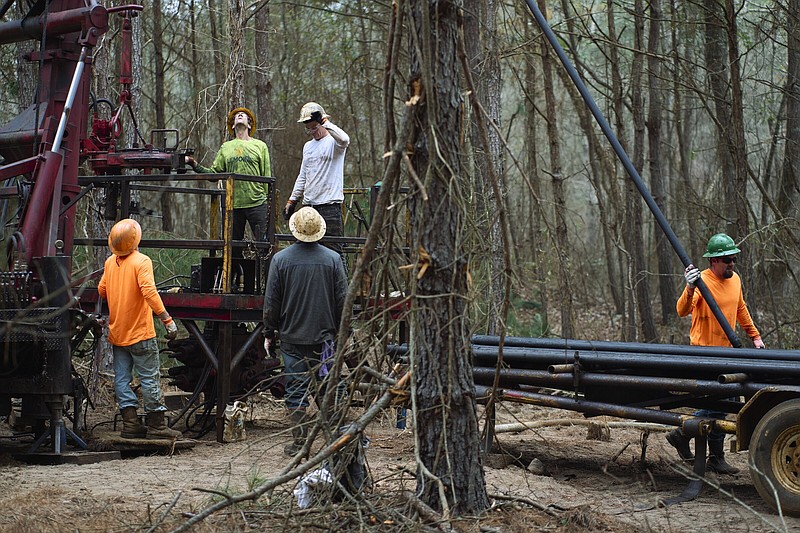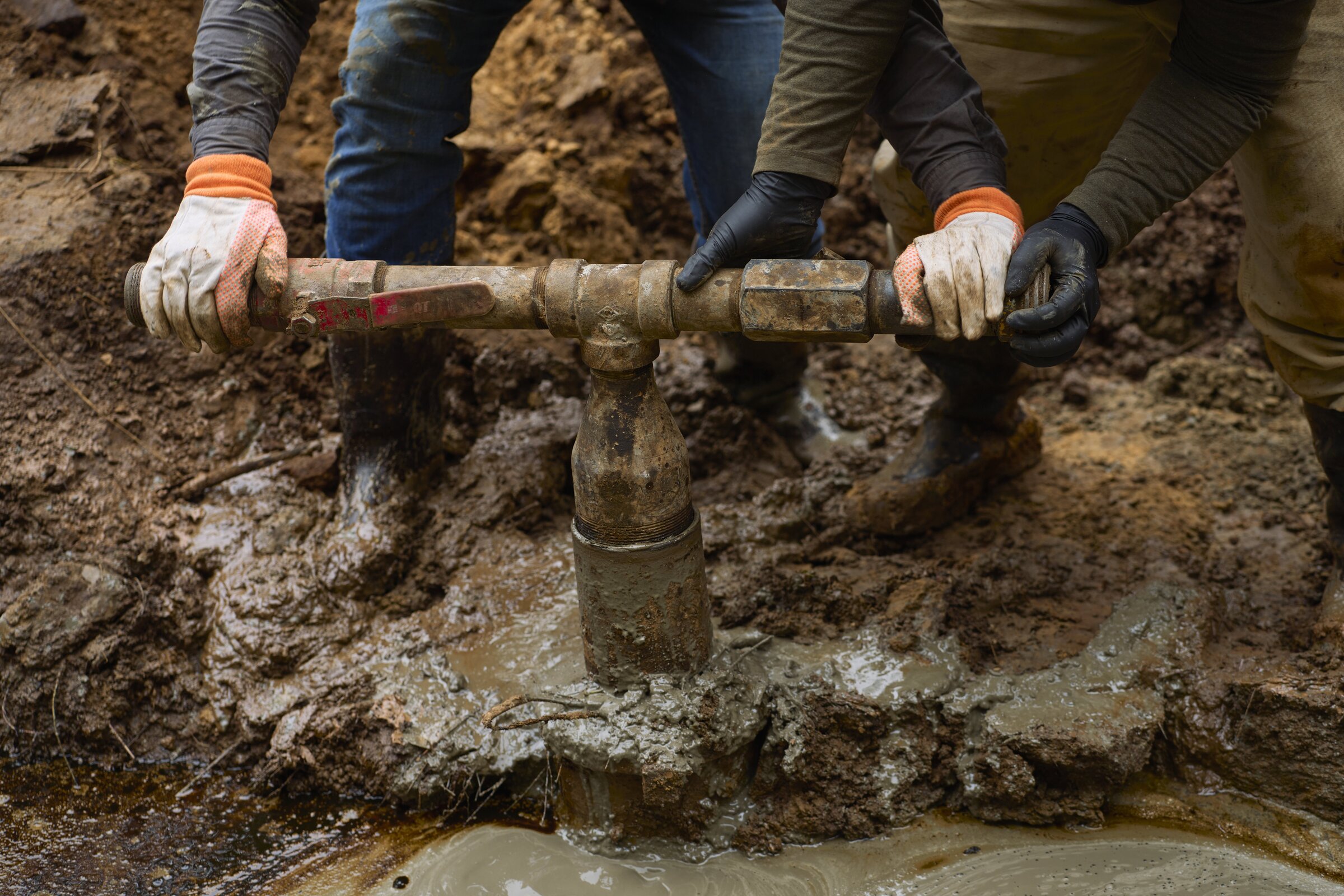OIL CITY, La. -- The events that led Joe Tolbert to Well No. 173054 recently began years ago, when President Biden promised to plug hundreds of thousands of abandoned oil and gas wells that "pose an ongoing threat to the health and safety of our communities."
Congress set aside an unprecedented $4.7 billion to fund the idea in late 2021, and by last fall the Interior Department began sending an initial $25 million to two dozen states to stamp out wells from Alabama to Alaska that were contaminating groundwater and leaking planet-warming gases.
Louisiana, home to more than 4,500 "orphan" wells -- named so because often no viable owner exists -- was among those to receive the infusion of federal money. The state hired outside contractors, who sought out local crews with the equipment and experience needed to do the difficult work of dismantling a long-festering environmental scourge, one well at a time.
That's how, on a gray morning in northwest Louisiana, in an area known as the Caddo Pine Island Oil Field, Tolbert and his three sons were once again among the cypress swamps and tall pines, pouring a half-mile's worth of concrete that would officially end the life of Well No. 173054.
"We're dedicating everything to this right now," said Tolbert, 58, who owns Tolbert Construction in nearby Oil City. He previously spent years servicing wells in this once-prosperous corner of the state, but that work fluctuated with the industry's inevitable peaks and downturns.
"It's been an up-and-down ride," he said, noting that there's even a road called the Boom or Bust Byway that runs through town. Since January, his small business had found reliable work plugging dozens of rusty, leaking wells that litter this rugged landscape.
The push from the federal government to wrangle a problem that historically has received little attention marks a historic shift that could have profound impacts. Dedicating billions of dollars to target the most troublesome wells around the country has the potential to result in significantly fewer toxic substances, such as arsenic and benzene, polluting groundwater.
Also, while individual orphan wells don't typically leak large amounts of methane, collectively they account for a significant source of the potent greenhouse gas. So plugging the worst offenders has a clear climate benefit, scientists say.
"The more we plug and the faster we plug, the more methane we are capturing," said Ben Diebold, executive vice president for disaster services at Lemoine, one of the two firms with which Louisiana has contracted.
Still, a daunting task lies ahead.
'SCRATCHING THE SURFACE'
Merely locating orphan wells can be arduous, and plugging them is tedious, time-consuming and expensive. To follow a crew like Tolbert's is to understand how the work is a mixture of sweat, science and improvisation. They must navigate swampy roads or thick forests with heavy equipment to access the wells, remove miles of steel piping, set underground plugs to prevent fluid from flowing, fill strawlike holes with cement, remove the well head, and restore the land to something resembling normal. The whole endeavor takes days, and can cost $30,000 to plug a single well -- and sometimes far more.
Multiply that times the staggering number of wells around the country, and it's clear that the current funding, while monumental compared to anything in the past, will only begin to chip away at the problem.
The money pouring into states to do this work is "supercharging" the modest efforts that previously existed, said Adam Peltz, a director and senior attorney at the Environmental Defense Fund who has worked on the issue for years.
But, he added, "we are only scratching the surface on this. We really only know where a fraction of them are."
The wells are everywhere.
They're in backyards and buried under thorny thickets in suburban woods. Rusted pipes rise from the farmland of Texas and New Mexico, from an Amish community in Kentucky, from the bayous in Louisiana and dense forests in Pennsylvania and Ohio. They have been found under sidewalks and driveways, houses and apartment buildings -- and in at least one Wyoming schoolyard.
Some wells are a century or more old, dating to an era when there was little to no regulation throughout much of the country. Others were drilled more recently, and abandoned over time as fossil fuel companies or small speculators went belly up or simply left them idle. Until recently, states had few incentives to identify the aging wells and scant resources to plug them.
Last year, researchers at EDF and McGill University published an analysis of more than 120,000 documented orphan wells in 30 states. Using census data, it detailed how 14 million people live within a mile of an orphan well, including 1.3 million adults with asthma.
According to the analysis, Ohio had the highest number of orphan wells on its books, at more than 20,000, followed closely by Pennsylvania. But state officials and the researchers behind that work acknowledge that such numbers only begin to capture how many actually exist.
The Interstate Oil and Gas Compact Commission estimates the number of undocumented orphan wells to be between 310,000 and 800,000, though due to poor record keeping during much of the industry's century and a half of production, that number is likely even higher.
According to its most recent national inventory, the Environmental Protection Agency estimates the actual number of abandoned wells around the country could be in the millions, and that the methane that leaks from them each year accounts for nearly 3% of the U.S. total.
As states scour their records and their landscapes for long-forgotten wells to add to the list of those that need capping, the federal government is doing the same.
The Bipartisan Infrastructure Law included $30 million to help establish a research consortium aimed at helping develop technologies and best practices for locating orphan wells, measuring the amount of methane leaking from them and prioritizing which to plug.
THE SEARCH GOES ON
That has allowed Natalie Pekney, an engineer with the National Energy Technology Laboratory, and other Energy Department researchers to undertake a unique kind of detective work.
They have used drones, electromagnetic field detectors and other remote sensing technology to scour for orphan wells on public lands from Pennsylvania to Oklahoma. They have pored over topographical maps and historical photos, hiked through creeks and hacked through brush trying to pinpoint wells.
Sometimes, Pekney said, "They are really hard to find even if you can navigate within 30 meters."
After they locate a well, they measure any methane emissions from it and record its GPS coordinates. The idea, she said, is not to hunt down every well across the country, but rather to develop tools and methods that states can use to more strategically find existing wells and plug the most egregious environmental offenders.
"This is a methane emissions source we know how to mitigate," she said. "We can go out and do it."
Curtis Shuck, a former oil and gas executive, jokes that he got into the well-plugging game "long before orphan wells were cool."
What began with an epiphany several years ago after he witnessed abandoned wells dotting an old oil field in northern Montana soon became a nonprofit known as the Well Done Foundation, whose work has been funded primarily by philanthropic donors and corporate sponsors.
Shuck believes there is a financial model to support the work, even though it can cost into six figures to plug troublesome wells, depending on the difficulty of accessing their location and other circumstances. He is confident that donors will back the work because there are immediate, tangible benefits in preventing pollution and reducing methane emissions.
His foundation also has backed a carbon accounting methodology that, if adopted by the American Carbon Registry, could offer an incentive for businesses that want to offset emissions. Already, the nonprofit is plugging or monitoring wells in about a dozen states and has plugged 25 wells so far, with plans to keep expanding.
"This market-based solution has to be one of the tools in the toolbox," Shuck said, because even the hefty funding from Congress is not enough to solve the sprawling problem.
Peltz, from the Environmental Defense Fund, said there's plenty of work to go around.
"The problem is so vast that we need all participants," he said. "Anyone who wants to plug a well and is competent, the more the merrier."
In coming months, states will be scrambling to plug as many leaky wells as possible and measure the emissions they are preventing, in part because if they prove adept at the task, larger rounds of potential funding lie ahead.
At the same time, the federal government is also busy extinguishing old wells in national parks and wildlife refuges.
The National Park Service says it has identified roughly 1,800 oil and gas wells across at least 47 parks, and has undertaken more than two dozen projects to restore the land using money from the infrastructure law.
"We consider our grounds team to be like Indiana Jones," Julia Brunner, branch lead of the agency's Energy and Minerals Program, said in a release about the program. "They are out there in the wilderness with hatchets, sometimes fighting off alligators to find these wells."
The U.S. Fish & Wildlife Service received more than $13 million to remediate 175 orphan wells across six national wildlife refuges in Oklahoma and Louisiana. That work is also underway.
But erasing the backlog is a tall order, in part because of the remote location of some wells, and also because their number is not static.
"There are wells that are going into orphan status as we speak," Jimmy Laurent, the agency's Southeast regional energy coordinator, said in an interview.
Patrick Courreges, spokesman for the Louisiana Department of Natural Resources said the funding the state generates through a fee on oil and gas production -- typically about $10 million annually -- has allowed the state to plug roughly 150 wells a year. Meanwhile, an oil and gas downturn in recent years has caused the number of abandoned wells to surge past 4,500.
"We've been losing ground," Courreges said.
That is a key problem some other states are also trying to address.
While oil and gas operators in most states must submit "financial assurance" plans for how they intend to pay for plugging wells when they cease being productive, those plans often do not cover the full costs if companies walk away or go bankrupt.
Regulators in Colorado last year crafted tougher rules intended to keep more wells from slipping into orphan status, and imposed new funding requirements paid for by the industry to cover the costs for those that do. Officials in states such as Utah, Louisiana and Pennsylvania are considering measures with similar goals, Peltz said.
"This is all doable," he said, adding that sensible regulation and enforcement can prevent many active wells from becoming the "next generation" of orphan wells. "The policy tools to fix it are known."

